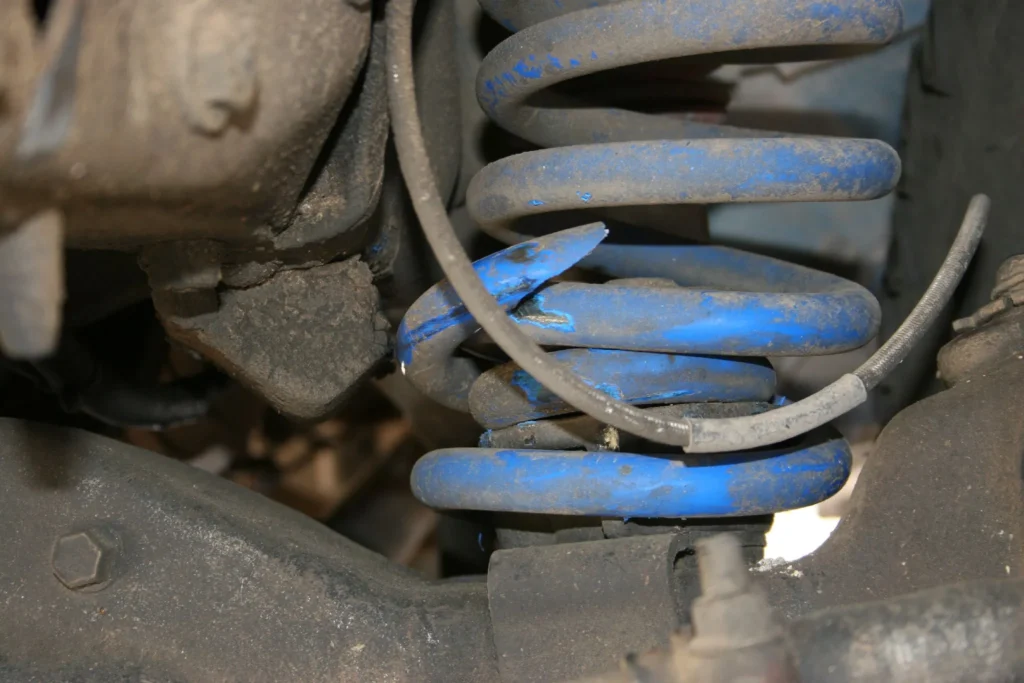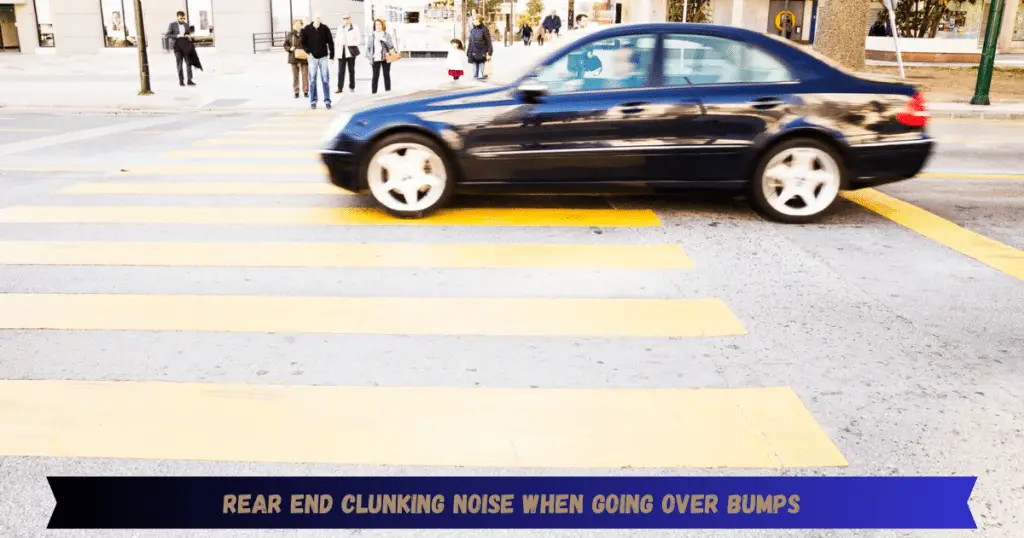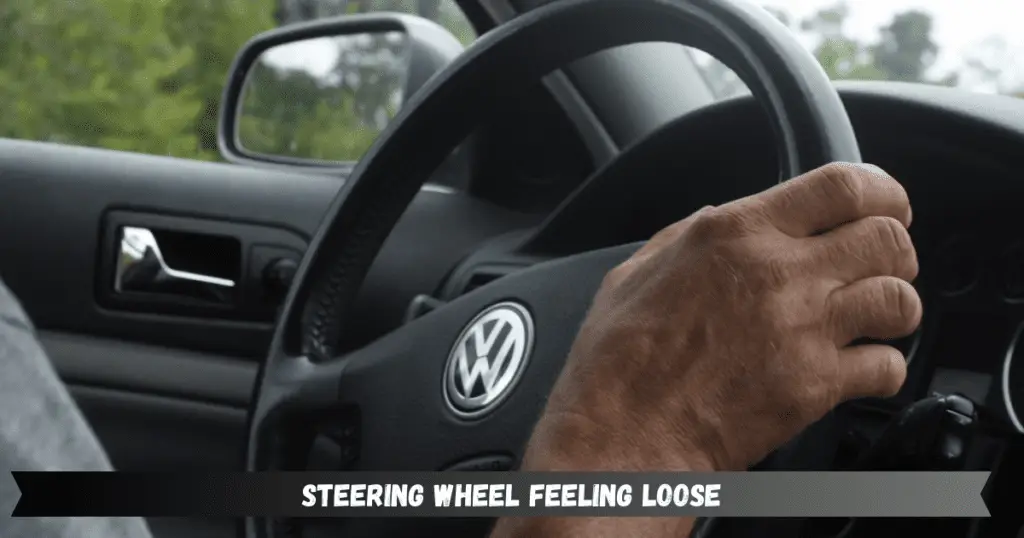Driving with a broken coil spring can be extremely dangerous. A coil spring is a vital component in your vehicle’s suspension system, absorbing impacts from bumps and uneven road surfaces. When a coil spring breaks, it compromises your vehicle’s handling, stability, and safety.
This comprehensive guide will cover everything you need to know about the risks and dangers of driving with a broken coil spring.
What is a Coil Spring and What Does it Do?
Before jumping into the hazards of a broken spring, let’s first understand what a coil spring is and its function in your car’s suspension.
A coil spring, also known as a helical spring, is a mechanical device tightly wound into a spiral shape. Coil springs are typically made from hardened steel.
Every car has four coil springs – two at the front and two at the rear. The springs work in conjunction with shock absorbers which control the up and down movement of the wheels when driving over bumps.
Here are the main jobs of coil springs in your car’s suspension system:
- Absorb impacts – The spring compresses when the wheel hits a bump and expands again to dampen the impact. This protects other components from damage.
- Maintain ride height – Coil springs support the weight of the vehicle and determine the ride height. Broken or sagging springs will cause the car to sit lower.
- Improve handling – Springs keep the tires firmly planted on the road. This maximizes traction for better control when cornering, accelerating, and braking.
- Provide a smooth ride – By absorbing vibrations, springs give a comfortable ride quality and isolate passengers from bumps and noise.
- Distribute weight evenly – Coil springs ensure the car’s weight is evenly distributed across all four wheels for balanced handling.
Is it Safe to Drive With a Broken Coil Spring?
Now that you understand the importance of coil springs, let’s get to the crucial question – is it safe to drive with a broken coil spring?
The short answer is no, it is extremely unsafe to drive with a broken coil spring.
A broken spring will no longer be able to perform its job of absorbing impacts and supporting the vehicle’s weight.
Dangers Of Driving With a Broken Coil Spring:

Car Sits Crooked and Lower on One Side
When a coil spring breaks, that corner of the car will sit lower than the others, causing the vehicle to look lopsided or crooked.
On front-wheel drive cars, this can cause serious issues with the CV axle angles, potentially leading to CV joint failure.
Reduced Control and Stability
With a broken spring, your ability to properly control and maneuver the vehicle decreases significantly. Turning, braking, and acceleration will all be affected.
The broken spring cannot absorb shocks, leading to bouncing and swaying. This makes the car wander and pull to one side. You’ll have to over-correct just to keep it straight.
Uneven Wear on Tires
The lowered vehicle height on the side with the broken spring causes uneven tire wear. The tire on that corner wears faster since it bears more load. This leads to premature tire replacement.
Other Suspension Damage
A broken spring places more stress on surrounding suspension components, potentially causing damage to ball joints, control arms, struts, and wheel bearings.
Safety Hazard to Other Drivers
There’s also a chance the broken coil spring can fall out from under the vehicle while driving and become a dangerous road hazard for other motorists.
With all these concerns, it’s clear that driving with a broken coil spring poses a serious safety issue for yourself and others on the road.
What Happens if You Drive With a Broken Coil Spring?
Now let’s take a closer look at some of the specific problems you’ll encounter if you attempt to drive with a broken coil spring:
Difficult Steering and Loss of Control
With a broken coil spring, your steering wheel will pull to the side with the damaged spring, forcing you to over-correct just to keep driving straight.
Turning the wheel can cause the spring to drag across the spring seat making the steering wheel jerk suddenly. You may have little control in emergencies.
Noisy Ride
As you drive over bumps, you’ll hear loud banging or clunking noises from the broken spring shifting and vibrating against other components. This worsens with larger bumps.
Rougher Ride Quality
The broken spring cannot cushion your ride from road imperfections. You’ll feel every minor bump and hole in the road. The ride feels bouncy and uncomfortable.
Uneven Braking
Braking performance can suffer. The lowered vehicle height over the broken spring causes braking force to be unevenly distributed. This could lead to pulling, swerving, or longer stopping distances.
Damage to Other Parts
Continuing to drive on a damaged spring applies more stress on struts, ball joints, and bushings and can even cause tire or wheel damage if the spring punctures a tire sidewall. This leads to additional repair costs.
Increased Chance of Blowouts or Crash
Between difficulty steering and braking combined with compromised handling, your risk of a crash or blowout increases substantially. A broken spring makes controlling the vehicle extremely difficult.
It’s clear that driving with a broken coil spring jeopardizes your safety and creates hazardous conditions. Have the vehicle towed to a repair shop immediately.
What Causes a Coil Spring to Break?
Now that you know the dangers of driving on a broken coil spring, what causes coil springs to break in the first place?
There are a few common reasons coil springs fail:
Age and Wear
Coil springs naturally weaken over time from absorbing millions of suspension impacts. After 50,000-100,000 miles, springs lose their tension and become prone to cracking or breaking, especially on roads with potholes.
Corrosion
Road salt, water, and dirt cause the steel in springs to corrode and rust over the years. This corrosion eats away at the metal, leading to thinning and eventual snapping.
Overloading
Carrying heavier loads, towing, or adding modifications like a lift kit places more strain on coil springs. This accelerates the wear and can overload springs beyond their tension capacity.
Manufacturing Defects
While rare, some springs have imperfections or flaws from the factory that cause premature failure. Weak spots lead to cracks or break well before expected.
Excessive Impacts
Hitting major potholes or obstacles at high speeds represents an impact beyond the spring’s tension strength, causing it to crack or shatter. These acute impacts can damage even brand-new springs.
Leaking Struts
Leakage of hydraulic oil from a strut will cause a spring to work harder to support the vehicle’s weight. This places excessive strain on the spring which leads to failure.
By staying aware of these common culprits, you can help avoid spring failure through proactive replacement before they break.
Signs Your Coil Spring is Breaking
How can you detect a coil spring is wearing out before it breaks while driving? Watch for these key warning signs:
- The vehicle is lower on one side, uneven, and crooked looking. Use a tape measure to compare the ride height on all four wheels.
- You hear a knocking, clunking, or popping noise when going over bumps.
- The car bounces and sways more than usual.
- Excessive vibration is felt through the steering wheel and seats over small bumps.
- Sudden loss of ride height after hitting a pothole or driving over railroad tracks.
- Cracks, damage, or corrosion visible on the coil springs when inspecting under the car.
Don’t ignore these symptoms of worn coil springs or you could be left stranded with a broken spring. Have them inspected and replaced before they fail.
Can You Drive With a Broken Rear Coil Spring?
You may be wondering if you can still drive with a broken rear coil spring or if it’s only dangerous when the front springs are broken.
While a rear broken spring is slightly less dangerous than a front, it is still highly inadvisable to drive with a broken rear spring.
Here are the main risks:
- Difficulty maintaining control around corners, on curves, and in emergency maneuvers. The rear loses traction.
- Fishtailing, swaying, and instability at highway speeds make the car feel loose.
- Continued driving damages other rear suspension components including shocks and control arms.
- Uneven rear brake force distribution lengthens stopping distances.
- The jagged broken spring can puncture the rear tire, especially if bottoming out.
The takeaway? A broken rear spring maintains all the same risks and dangers as a broken front spring. Do not drive the vehicle and have it towed for repair.
Broken Coil Spring Repair Cost
What’s the typical cost to repair a broken coil spring?
Repairing a broken coil spring isn’t inexpensive. The costs include:
- $150-$300 for a new replacement steel coil spring. The price depends on whether replacing the front or rear and the vehicle make/model.
- $150-$250 for labor. At least 1 hour is required to disassemble the corner and install the new spring. Shop rates vary.
- $100+ for an alignment. A broken spring requires a wheel alignment to restore proper suspension angles.
So in total, expect to pay $400-$700 to fix one broken coil spring. Costs are higher if other suspension parts are damaged.
Keep in mind both springs on the same axle should be replaced as a pair to prevent premature failure of the old spring on the other side.
Broken Coil Spring Noise
One distinct symptom of a broken coil spring is a loud clunking or popping noise, especially when driving over bumps. This noise occurs because:
- The broken spring ends bang and vibrate against the metal spring seats.
- With no spring tension, suspension components shift and knock together.
- The spring drags across other metal components under the car.
Listen for these types of sharp, sudden broken spring noises after hitting a pothole or bump. They indicate imminent spring failure.
Frequently Asked Questions
Can I Drive With a Broken Coil Spring?
No, it is strongly advised not to drive with any broken coil spring due to safety concerns and further damage that can occur. Have the vehicle towed to a repair shop.
Is it Safe to Drive on a Broken Coil Spring?
Driving with a broken coil spring is extremely unsafe. A broken spring cannot support the vehicle’s weight, absorb impacts, or dampen vibrations. This leads to a loss of control, difficult steering, suspension damage, and potential tire failure or crashes. Do not drive with a broken coil spring – the risks are too high.
How Long Can I Drive With a Broken Coil?
You should not drive more than a few miles with a broken coil spring, if at all. The handling and control of the vehicle will be severely compromised. Only drive the short distance to a safe place to have the vehicle towed for service. Any extended driving risks the spring puncturing a tire or hurting someone if it falls out.
What Damage Can a Broken Coil Spring Cause?
A broken coil spring can lead to many issues if you continue driving, including:
- Reduced steering and braking control
- Rougher ride and bouncing
- Clunking spring noises
- Uneven tire wear
- Strut, ball joint, and tie rod damage
- Crash or blowout risk
Have it repaired immediately to avoid creating secondary damage from the broken spring.
Is it Safe to Drive with a Broken Shock Absorber?
No, driving with a broken shock absorber is dangerous for handling and control. Since the shock can’t dampen spring vibrations, it causes bouncy rides, swaying, and compromised emergency maneuvers. Replace broken shocks promptly.
What Does a Bad Coil Spring Sound Like?
Pay attention to these sounds indicating a bad coil spring:
- Loud clunks when driving over bumps
- Popping or snapping noises when turning
- Scraping noise as the spring drags under the car
- Banging and rattling as spring ends hit components
These noises likely mean the spring has broken or will soon. Have it inspected immediately?
What is the Lifespan of a Car Coil Spring?
On average, coil springs last 50,000-70,000 miles. For vehicles driven on smooth roads, they may last up to 100,000 miles before replacement is required. Inspect springs regularly for corrosion and replace them proactively.
Conclusion
We’ve covered everything you need to know about the substantial Dangers of driving with a broken coil spring. A broken spring cannot support your vehicle properly and jeopardizes your ability to steer, brake, and maintain control. Never drive with a known broken spring – the dangers are serious. Have the vehicle towed to prevent any further damage or a potential accident. Address any symptoms of worn springs early before they leave you stranded with a broken spring. Follow recommended spring maintenance and replacement intervals.





